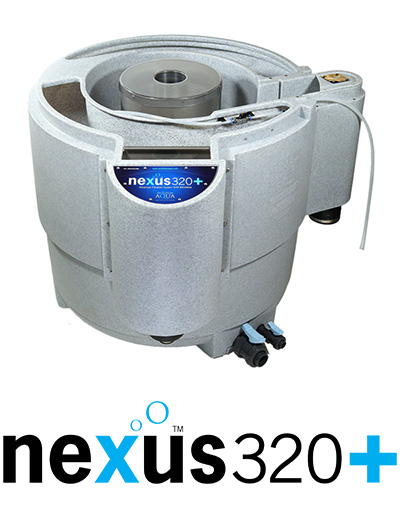

Evolution Aqua have launched the Nexus320+ and Nexus220+ filtration systems. Building on the tried and tested technology that has been ever present in the world renowned Nexus, the team at Evolution Aqua have gone even further to enhance their number one Koi pond filter.
The Nexus320+ and Nexus220+ filters now come with a new filter media called K+Media in the moving bed outer chamber for vastly improved biological filtration and faster filter maturation. The new Nexus+ filters are also supplied “auto ready”, with factory fitted fixings already in place, making it even easier to upgrade to the Nexus Automatic Cleaning System.
Faster filter maturation and unrivalled water clarity
Advanced Filtration System with K+Media
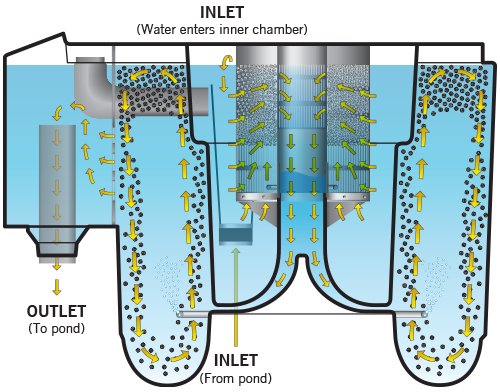
Nexus+ Dimensions
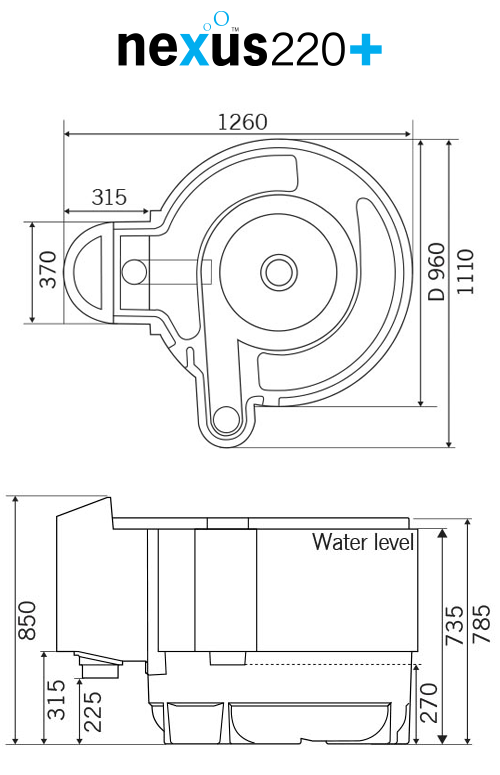
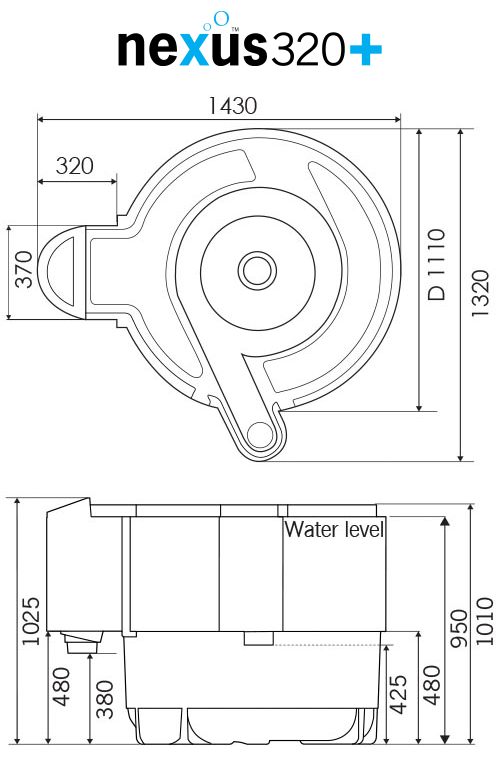
Installing the Nexus+
The Nexus+ MUST be installed on a solid, level base, a minimum of 1.2 metres x 1 metre. Failure to do this will cause irreparable damage to the filter and will therefore invalidate your warranty.
GRAVITY-FED INSTALLATION
By this we mean that your pump is going to be used to return the filtered water to the pond and therefore your filter will be supplied by gravity via a larger diameter pipe. In this situation the water level in the filter will be at the same level as the pond.
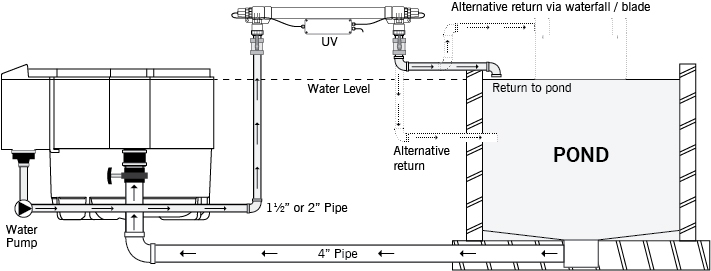
PUMP-FED INSTALLATION
Nexus filters can also be installed on pump-fed set-ups, but user needs to swap fittings around on inlet and outlet. In this application the Pump is loccated in the pond and pushes water into the Nexus. The filtered water then returns to the pond via gravity.
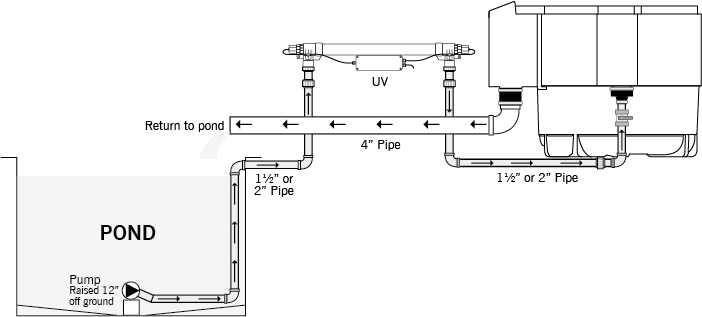
Specifications
Nexus 220+
- Max. Pond Size: 18,000 litres / 4,000 gallons / 4,800 US gallons
- Max. Flow Rate: 10,000 lph / 2,200 gph / 2,640 US gph
- Volume of water in Neuxs: 510 litres / 112 gallons / 135 US gallons
- Amount of K1 Micro Supplied in Eazy Filter: 18 litres of K1 Micro inside the EAZY
- Amount of K+Media Supplied in Bio Chamber: 50 litres of K+Media in bio chamber
- Max. Capacity for K+Media: 150 litres of K+ Media in bio chamber
Nexus 320+
- Max. Pond Size: 34,000 litres / 7,500 gallons / 9,000 US gallons
- Max. Flow Rate: 13,000 lph / 2,859 gph / 3,431 US gph
- Volume of water in Nexus: 840 lires / 185 gallons / 225 US gallons
- Amount of K1 Micro Supplied in Eazy Filter: 20 litres of K1 Micro inside the EAZY
- Amount of K+Media Supplied in Bio Chamber: 100 litres of K+ Media in bio chamber
- Max. Capcity for K+ Media: 300 litres of K+ Media in bio chamber
New advanced filtration media
Plastic media, for use in biological pond filters - specifically in moving bed bio reactors, was pioneered by Evolution Aqua, some 20 years ago. In recent years, other plastic media have come onto the market, usually with the aim of trying to get more and more surface area. However, one drawback to using plastic media has always been the time it takes to establish a stable biofilm – essential for good filtration.
After many years of research, Evolution Aqua have now developed a new media that not only gives class leading surface area, but also overcomes the problem of long maturation times.
K+Media is designed and manufactured in the UK by Evolution Aqua. This advanced media, with its innovative design, and class leading surface area provides enhanced biological and mechanical filtration.
As Evolution Aqua extrude K+Media, Minerals and Enzymes are added to the raw material. The result of this process, unique to Evolution Aqua, is a filtration media that not only outperforms most of its competitors due to its large protected surface area, but also answers the problem of how to speed up the time taken to mature your filter.
Increased surface area
With a new shape and profile, K+Media has also been designed to have an increased and class leading surface area, meaning an overall surface area of 1,350m2 per m3. More importantly for biological filtration, the protected surface area of K+Media is 1,025m2 per m3. This allows a stable bio-film to form and remain intact when used in moving bed biological filtration, as in the new Nexus+.
Increased surface area
With a new shape and profile, K+Media has also been designed to have an increased and class leading surface area, meaning an overall surface area of 1,350m2 per m3. More importantly for biological filtration, the protected surface area of K+Media is 1,025m2 per m3. This allows a stable bio-film to form and remain intact when used in moving bed biological filtration, as in the new Nexus+.
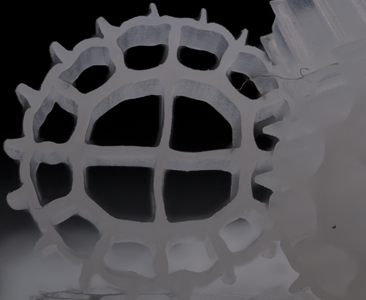
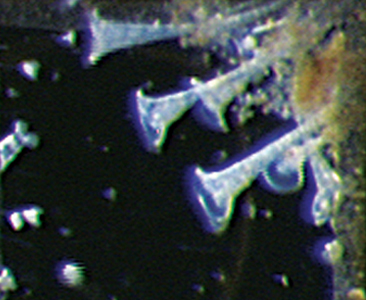
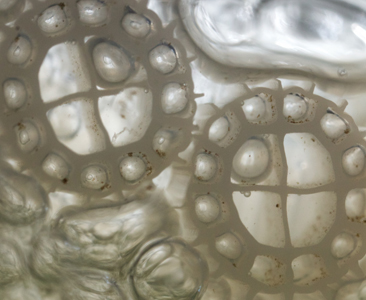
Stable bio-film development
The shape of K+Media optimises the amount of “quiet zones” within the media where a stable bio-film can develop. Whilst K+Media keeps the integral profile of K1 Media at its core, there is an extra layer of cells and fins around the outside of each piece that enable microscopic organisms such as Rotifers and Vorticella to thrive. This is an additional benefit as competitor media do not have such “quiet zones” that would allow these higher lifeforms of filter feeders to develop. The bacteria and organisms that form within the bio-film ensure the media delivers optimum levels of biological filtration in the moving bed, which has been proven filtration technology for many years in the fishkeeping hobby.
Use with PURE Pond products
Evolution Aqua also recommend using K+Media in combination with the PURE Pond and PURE+ Filter Start Gel to boost bacteria levels which in turn will stick to the media and speed up the maturation process even more.

